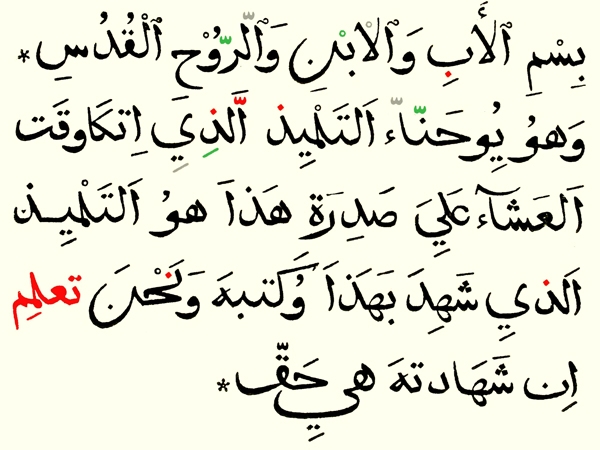Eurabic


Some time ago at the Mueum Plantin-Moretus I took a photo of one of the Le Bé fragments collected by Max Rooses, who was the first curator of the museum, and inserted by him in what is documented as Volume 153. The Arabic type in question has been attributed to Le Bé, but it is not sure whether he cut it himself. In any case: the type is a faithful copy of one of the Eurabics that Granjon cut in Rome between 1583 and 1586.

First of all Sabert checked the texts and consulted some experts. This resulted in the mapping of the mistakes in the image above: the text on top is from the specimen and below as it should be.

The design by Le Bé / Granjon shows a strange mix of Arabic scripts like Naskh, Thuluth, and Muhaqqaq. There are different forms of the characters, proportions and grammatical and linguistic mistakes.

For instance the image above shows the missing words, dots, the wrong words and incorrect diacritics.

And this image shows the different scripts that can be traced.
More to come!
Comments
-
Interesting post, Frank. This specimen was produced by Guillaume Le Bé II, the son, and it may well be Granjon's Arabic, as Le Bé I makes no mention of an Arabic type in his own specimen/log book.
Assuming it is the large Granjon Arabic, I wonder if a full specimen of this type couldn't be assembled from other printed works in which it appeared, such as the Evangelium Sanctum Domini Nostri Jesu Christi, published by the Typographia Medicea, in Rome, 1590. I believe Granjon cut three Arabics while in Rome. Huda Smitshuijzen Abi-Fares write about them in her book Arabic Typography: A Comprehensive Sourcebook, as did Wayne Osborn, in a 2008 UC San Diego dissertation, "The Type of Calligraphy: Writing, Print, and Technologies of the Arabic Alphabet," which is free to download.
Could it have that Le Bé II purposely used multiple forms incorrectly to show the range of characters in a small space? There's a specimen (which I can't find at the moment) of Granjon's Syriac in which the two different scripts are set together, something that would only happen in a demo.
3 -
Thanks Scott for your interesting comments!
Could it have that Le Bé II purposely used multiple forms incorrectly to show the range of characters in a small space?
After I posted a link to this topic on my Facebook account a couple of days ago, Thomas Milo pointed me at a highly interesting article he wrote on Bodoni’s Arabic. In his summery at the end of the article Thomas writes; ‘If Bodoni had fully understood this description, he would not have continued the tradition of mixing thuluth and naskh elements. It is clear that he directly or indirectly copied Granjon’s types […].’ This indicates that the mixing was deeply rooted in Eurabic.Assuming it is the large Granjon Arabic, I wonder if a full specimen of this type couldn’t be assembled from other printed works in which it appeared […]
That would be the next step for Sabert then. I think that the compactness of the print in question makes the start of such a research a bit easier.There’s a specimen (which I can’t find at the moment) of Granjon’s Syriac in which the two different scripts are set together, something that would only happen in a demo.
What interests me most, is whether there is a systematization/unitization in the Renaissance non-Latin scripts and if so: what was the effect on the proportions and details of the characters? The fact that –as you write– Granjon mixed different Syriac scripts points in the direction of such a standardization.
0 -
About mixing of styles, maybe you find this analysis useful:
http://www.compulsivebodoni.com/?portfolio=thomas-milo-bodonis-arabic-some-observations
0 -
BTW, there is a sequel to ‘The role of Dutch Arabic Typography in Middle Eastern Printing’, the talk that I gave in Istanbul a year later. There I show that the Tetterode copy of Mühendisoğlu's flawless naskh typeface introduces Eurabisms in the form of thuluth-inspired letter shapes. Needless to say all that the ligatures that were included to support script grammar were mismanaged as ornamental alternatives.
3
Categories
- All Categories
- 46 Introductions
- 3.9K Typeface Design
- 487 Type Design Critiques
- 565 Type Design Software
- 1.1K Type Design Technique & Theory
- 656 Type Business
- 861 Font Technology
- 29 Punchcutting
- 520 Typography
- 119 Type Education
- 324 Type History
- 77 Type Resources
- 112 Lettering and Calligraphy
- 33 Lettering Critiques
- 79 Lettering Technique & Theory
- 558 Announcements
- 94 Events
- 114 Job Postings
- 170 Type Releases
- 179 Miscellaneous News
- 276 About TypeDrawers
- 54 TypeDrawers Announcements
- 120 Suggestions and Bug Reports
